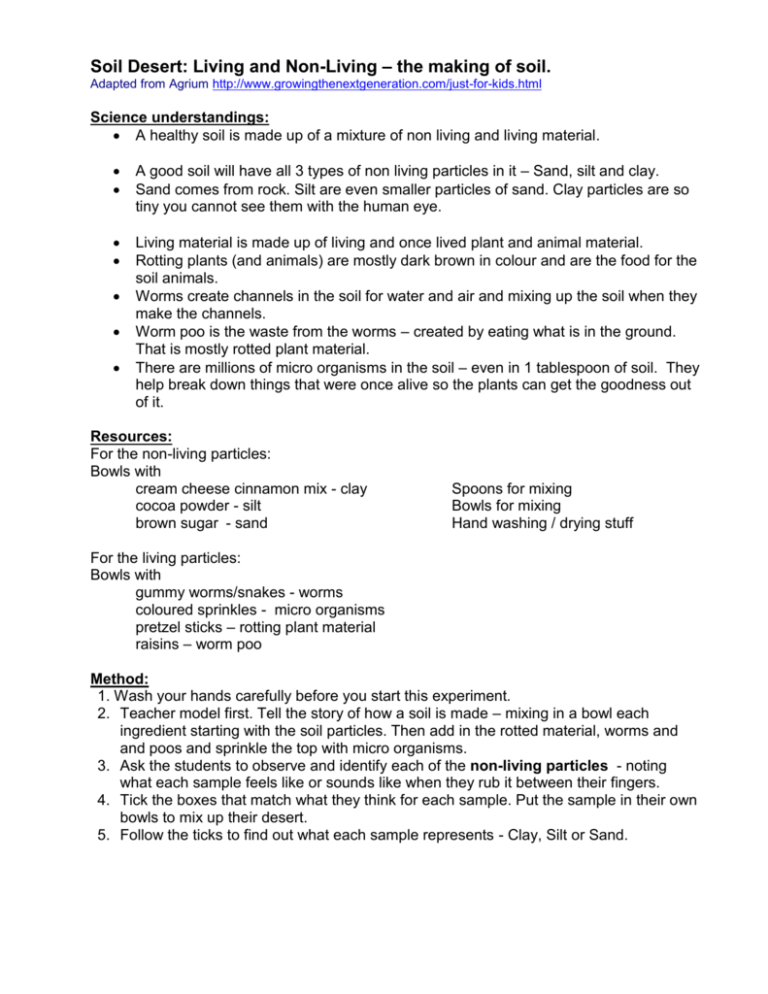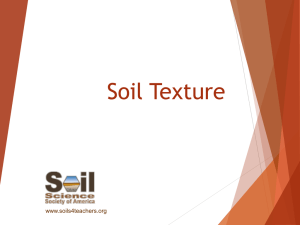Activity 1: What is Soil - Enviro
advertisement

Soil Desert: Living and Non-Living – the making of soil. Adapted from Agrium http://www.growingthenextgeneration.com/just-for-kids.html Science understandings: A healthy soil is made up of a mixture of non living and living material. A good soil will have all 3 types of non living particles in it – Sand, silt and clay. Sand comes from rock. Silt are even smaller particles of sand. Clay particles are so tiny you cannot see them with the human eye. Living material is made up of living and once lived plant and animal material. Rotting plants (and animals) are mostly dark brown in colour and are the food for the soil animals. Worms create channels in the soil for water and air and mixing up the soil when they make the channels. Worm poo is the waste from the worms – created by eating what is in the ground. That is mostly rotted plant material. There are millions of micro organisms in the soil – even in 1 tablespoon of soil. They help break down things that were once alive so the plants can get the goodness out of it. Resources: For the non-living particles: Bowls with cream cheese cinnamon mix - clay cocoa powder - silt brown sugar - sand Spoons for mixing Bowls for mixing Hand washing / drying stuff For the living particles: Bowls with gummy worms/snakes - worms coloured sprinkles - micro organisms pretzel sticks – rotting plant material raisins – worm poo Method: 1. Wash your hands carefully before you start this experiment. 2. Teacher model first. Tell the story of how a soil is made – mixing in a bowl each ingredient starting with the soil particles. Then add in the rotted material, worms and and poos and sprinkle the top with micro organisms. 3. Ask the students to observe and identify each of the non-living particles - noting what each sample feels like or sounds like when they rub it between their fingers. 4. Tick the boxes that match what they think for each sample. Put the sample in their own bowls to mix up their desert. 5. Follow the ticks to find out what each sample represents - Clay, Silt or Sand. When you look at the size of each particle … I am the largest particle. I am the mid sized particle. I feel … loose, gritty and rough like sandpaper. smooth and silky. When you rub me together … I will make a raspy sound. I will make a squeaky sound. I will make no sound. When you try to make me into a small ball … I will not stick together. I will only stick together when I am wet. I will roll into a ball easily. I will stick together. I am … Sand Silt I am the smallest. You will need a microscope to see me. smooth and sticky like glue. Clay 6. Add in the rotting plant material. It is no good to plants living in soil yet. 7. Add in the worms – remembering what they do - that they turn rotting plants and dead animals into poo. 8. Add in the poo – the worms have produced – reinforcing that the plants can now use this fertilizer - as the plants can access all the goodness in the rotted material. 9. Sprinkle on the micro organisms – they help the plant access the goodness from the worm poo and other such jobs. 10. Fill in the table to remind you who does what and whether I am alive or was alive once. 11. Mix it all up and taste sample your healthy dirt. I am a … I am create channels in the soil for water and air. I mix the soil particles up when I make the channels. I once was food that animals ate but now I am waste. I am mostly plant material. I am mostly dark brown in colour. I am food for the soil animals. There is lots of us, millions of us in a table spoon of soil. We help break down things that were once alive. Am I still alive or I was I once alive?







